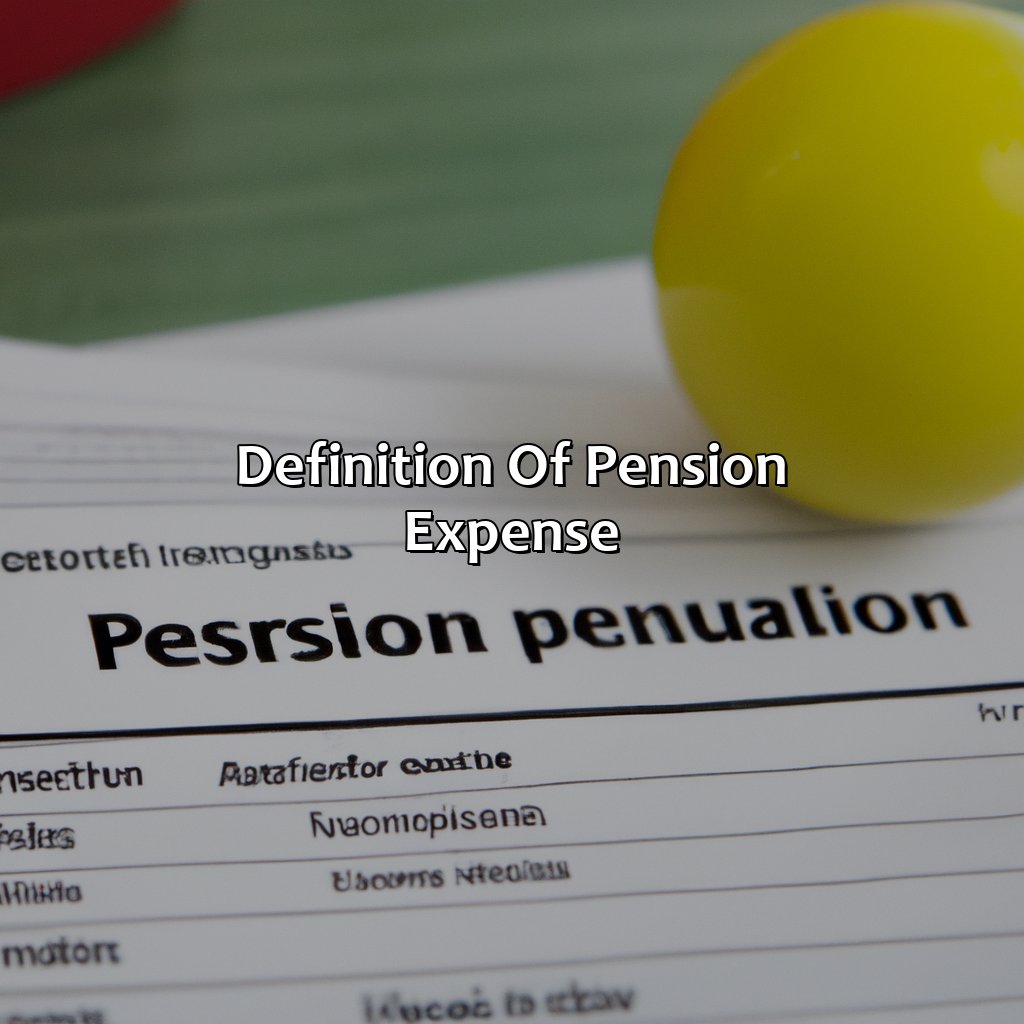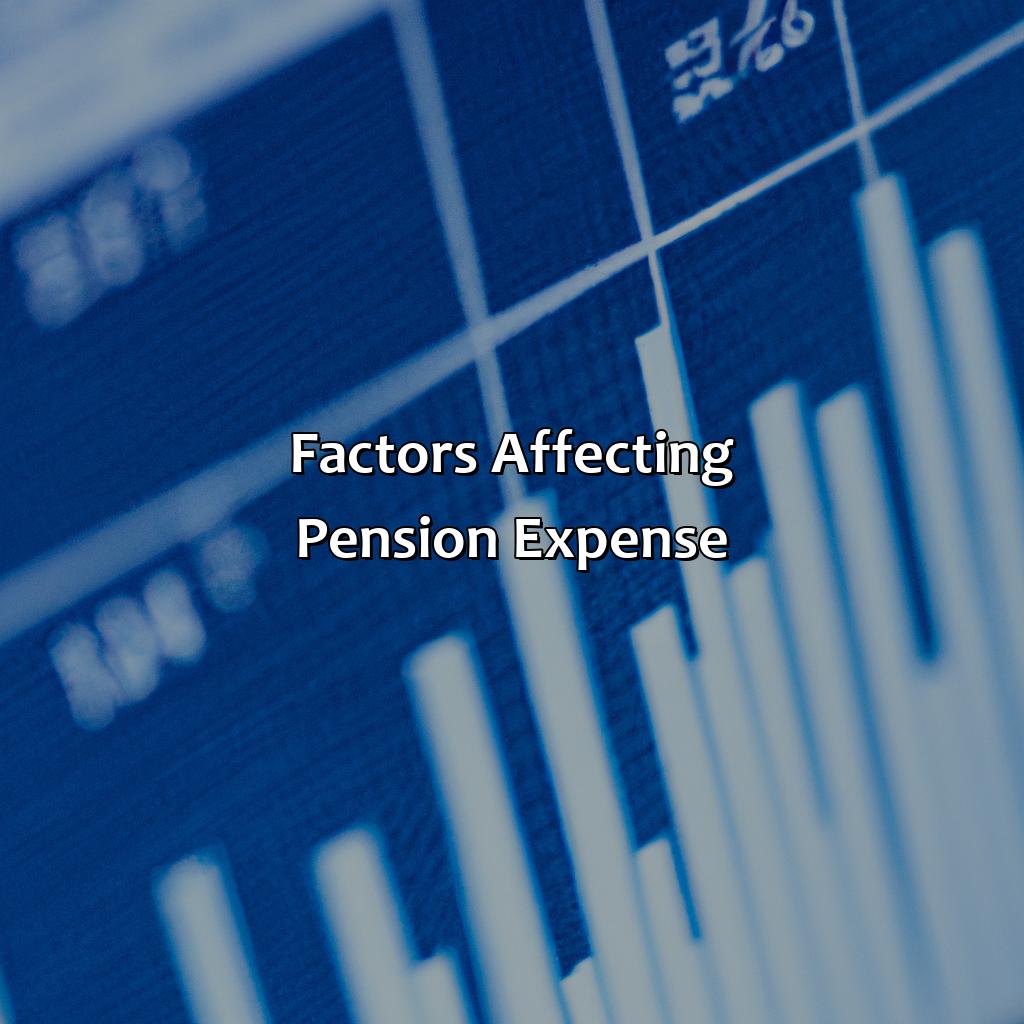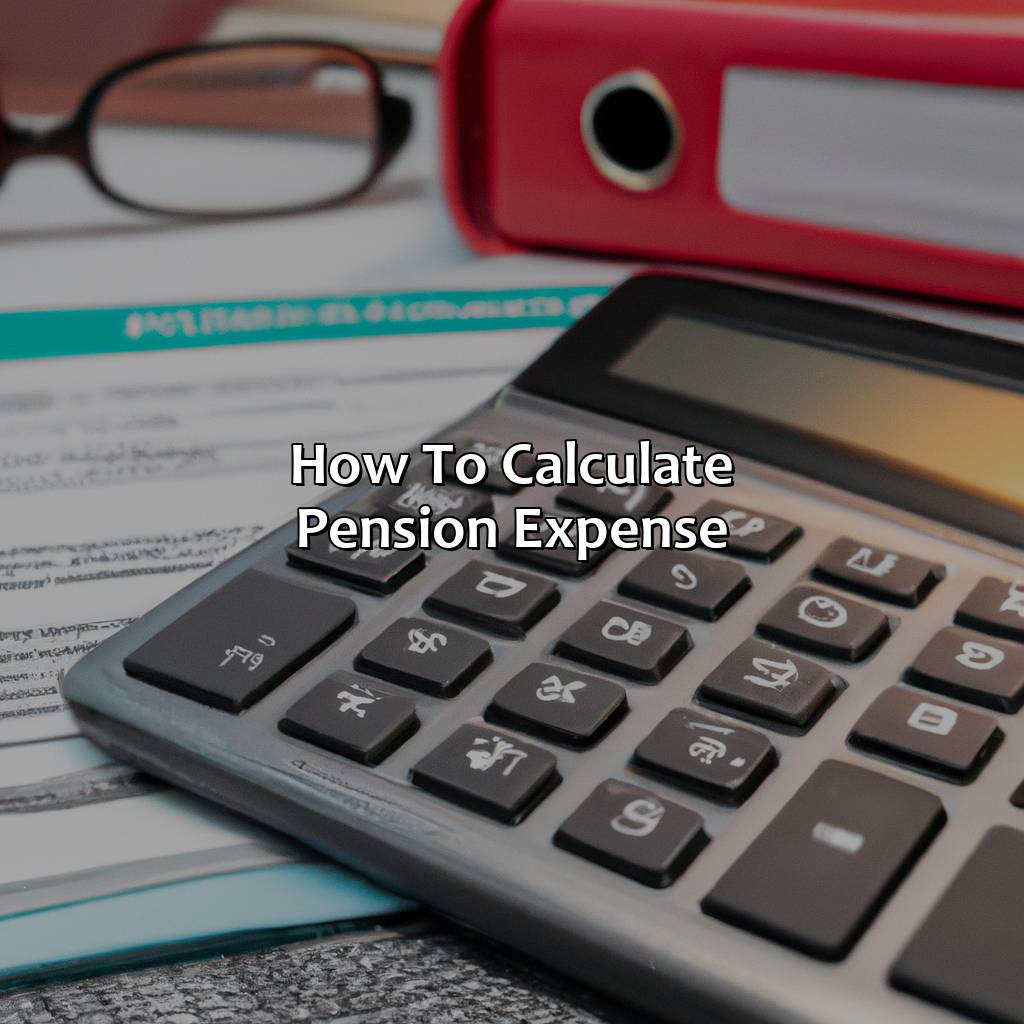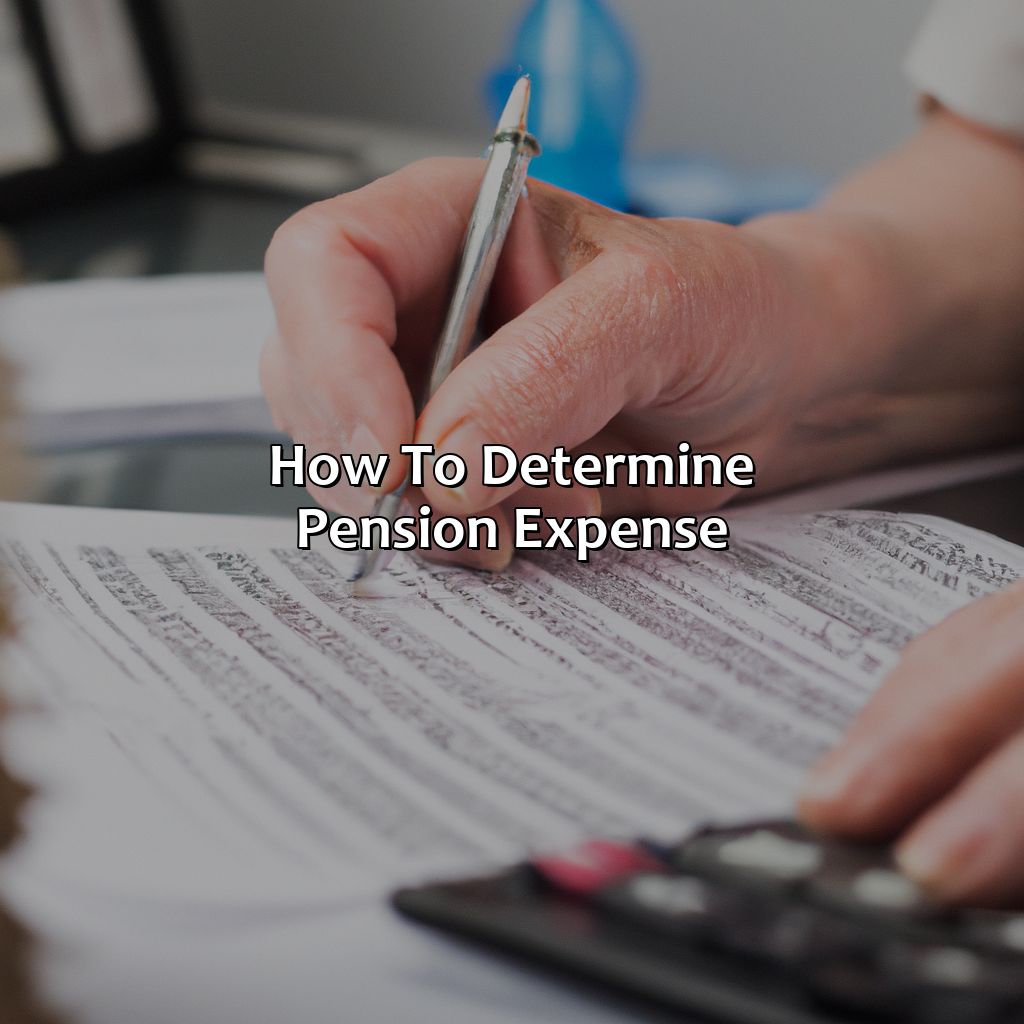How To Determine Pension Expense?
Key Takeaway:
- Pension expense is the cost that a company incurs to provide retirement benefits to its employees. It includes the cost of current and future benefits earned by employees
- Several factors affect pension expense, including actuarial assumptions and plan characteristics. These assumptions and characteristics may change over time, resulting in fluctuations in pension expense.
- Calculating pension expense involves several components, including service cost, interest cost, prior service cost, gain or loss, and amortization of existing costs. Companies must carefully consider these factors to accurately measure their pension expense and comply with accounting standards.
Are you concerned about how to accurately calculate your pension expenses? This article will provide a step-by-step guide on how to properly assess and determine the pension expense that you need to budget for. Learn the easy process today and take control of your retirement planning.
Definition of Pension Expense
Pension expense refers to the cost incurred by a company in providing retirement benefits to its employees. This expense is an important factor that needs to be taken into account while preparing a company’s financial statements. The amount of pension expense is based on several factors such as employee salaries, length of service, retirement age, expected investment returns, and actuarial assumptions.
To determine pension expense, companies use complex calculations based on actuarial science. These calculations consider various factors, such as the company’s current pension obligations and the expected return on pension investments. The incurred expense is then spread out over the employees’ working lives, resulting in a more accurate representation of the actual cost of providing pension benefits.
If you’re wondering how to get a pension, it’s important to first understand how pensions work. Companies offer pensions as a way to provide retired employees with a steady income stream after they leave the workforce.
It’s important to note that pension expense can vary significantly from year to year due to fluctuations in investment returns and other factors. Additionally, pension expenses for different companies can vary depending on the size and nature of their retirement plans.
In a real-life example, a large multinational corporation recorded a significant increase in pension expenses after a change in actuarial assumptions. This resulted in a decrease in earnings and raised concerns among investors and shareholders. As a result, the company had to revise its financial statements and provide more detailed disclosures regarding its pension plans. If you are wondering how to find your pension information, there are various resources available to help you navigate this process.
Overall, determining pension expense requires a thorough understanding of actuarial calculations and other factors that can impact pension costs. Companies must ensure that they accurately report these expenses in their financial statements to provide transparency and accountability to their stakeholders.

Image credits: retiregenz.com by James Duncun
Factors Affecting Pension Expense
Understanding pension expense requires considering various factors. Let’s go over the two main ones – actuarial assumptions and plan characteristics. They are key elements in accurately determining pension expense. We’ll explain how they work!

Image credits: retiregenz.com by Joel Duncun
Actuarial Assumptions
The assumptions made by actuaries are essential in determining pension expense. These include life expectancy, expected salary growth, discount rate, and turnover rate. Due to their long-term nature, small variations in these assumptions can lead to significant changes in pension expenses.
Actuarial predictions of future events are not certain and sometimes subjective, making it difficult to determine precise values for pension expenses. The use of these assumptions often involves analyzing past data and assessing future trends to better determine the probability of various outcomes. This process requires continuous evaluation as future events may differ from prior expectations.
It is vital to note that primary actuarial assumptions are subject to change based on economic circumstances or revised demographics that influence the longevity of employees. Employers must consider all factors that might affect actuarial valuations and adjust them accordingly.
According to NASRA (National Association of State Retirement Administrators), unfunded public pension liabilities totaled $1.4 trillion in 2019, up from $1.3 trillion in 2018, which highlights the importance of accurately determining pension liabilities through proper consideration of actuarial factors.
When it comes to pension plans, the characteristics are like a dating profile: you want something reliable, stable, and with no surprise fees.
Plan Characteristics
Starting with the specialized topic of ‘Plan Factors‘, it is essential to determine vital traits and features of any pension plan before calculating expenses. These factors involve crucial characteristics of the retirement plan that influence the expense calculation, such as funding levels, investment returns, benefits provided, discount rates, and more.
| Plan Characteristics | ||
|---|---|---|
| Funding levels | Investment returns | Benefits provided |
| Fully-funded | Positive | Defined |
| Underfunded | Negative | Hybrid |
| Partly funded | Zero | Cash balance |
This table shows some examples of Plan Characteristics. Funding levels may vary between plans based on how well they are sustained. Investment Returns decide the return the plan’s investments generate for a particular period; these can affect the pension expense calculation. Lastly, benefits provided differ from one plan to another – the type of pension benefit offered could have a direct effect on expenses.
Other significant aspects affecting capital outflow include age demographics, mortality rates, turnover rates or employee retention within the company. In other words, these are how many employees retire annually versus new workers being hired into the company.
For instance, at a past employer, when preparing their accounts for an audit by an external agency scrutinizing management’s work had been expensive. As it turned out when using previous years’ information recorded poorly in their database-creating discrepancies resulting in inaccurate records and accounting errors that needed to be corrected before filing taxes. This procedure was both tedious and costly due to the potential fines if correctly addressed promptly.
Pension expense calculations are like solving a Rubik’s cube, difficult to figure out but satisfying when everything fits into place.
How to Calculate Pension Expense?
Find out how to calculate pension expense quickly! This guide explains Service Cost, Interest Cost, Prior Service Cost, Gain or Loss, and Amortization of Existing Costs. Each of these subsections is essential for getting the total pension expense for a certain period.

Image credits: retiregenz.com by James Washington
Service Cost
When determining pension expense, one essential component that companies must calculate is the liability attributed to employees’ service. The calculation of this cost, commonly known as the cost of services rendered‘, takes into account the current period’s workforce’s expected future compensation and benefits. Companies should ensure that they perform accurate calculations in accordance with accounting principles and provisions required by regulatory authorities.
A company s pension obligation relies heavily on factors such as employee retention rate, workforce demographics and lifespan expectations, affecting the service cost determination.
In addition to estimating the necessary figures, it is vital that management closely monitors changes impacting these numbers throughout the year to avoid any material misstatements in their financial records. Successful management of a company’s pension plan depends on timely recognition of pertinent changes that inevitably influence their estimates, such as revisions to mortality tables or adjustments relating to the discount rate for calculating obligations. If you want to know more, you can easily check your pension to ensure you have the funds you need for retirement.
A renowned US airline was fined $50 million when they neglected to report changes associated with their pension obligation calculations. The firm s lack of oversight resulted in overstated profits appearing in their financial statements over several years. As a result of this malpractice, many employees lost significant retirement funds due to miscalculations from the employer. It serves as a cautionary tale for firms neglecting the importance of meticulous record-keeping and keeping tabs on pension fund expenses.
Calculating interest cost for pension can make your head spin, but at least your retirement savings won’t be spinning out of control.
Interest Cost
The cost attributed to the financing of a pension plan is known as interest expense. It is calculated based on the present value of future pension payments and the discount rate used to determine this value. The interest cost will increase if the discount rate used becomes smaller.
To determine interest cost, one should consider opening and closing balances, actual return on plan assets, contributions made, and benefits paid out during the period. To calculate it, multiply the opening balance by the discount rate and subtract any employer contributions. The resulting number is then added to the closing balance.
It’s important to note that changes in interest rates can significantly affect interest expense. As rates rise or fall, so too will the amount of money required to fund a pension plan over time. Therefore, companies need to reassess these numbers more often than usual and understand the concept of commuted value of pension.
The history books reveal an era during which interest cost calculations for pensions were not standardized. In 2006, however, the Financial Accounting Standards Board issued Statement No. 158 mandating rules for calculating and reporting all aspects of pension-related expenses, including estimating service costs and amortization periods for deferred gains or losses in pension funds over time. If you want to know more about how a pension is paid out, this article can be helpful.
Calculating pension expense is like trying to solve a Rubik’s Cube blindfolded, but with prior service cost, it’s like someone added a few extra colors just to mess with you.
Prior Service Cost
The expenses associated with past years of service are referred to as Past Service Expenses. This is a cost that the employer incurs for providing enhanced benefits to current employees, which they weren’t entitled to before. It could be due to an increase in terms of benefits or changes in plans provided by the organization. These costs are amortized throughout the working tenure of the employee, hence reducing future contributions for employers. However, employers should keep track of these expenses to ensure timely payments and avoid penalties.
To determine Prior Service Cost (PSC), various factors including updated payment details, plan amendments and retiree benefits need to be taken into account. The PSC shows up as an expense in an organization’s financial statements that need review and approval by a qualified actuary. As this cost classification is highly complex, organizations can consider outsourcing services from reliable third-party vendors specialized in calculating pension value for divorce.
It is worth noting that PSC values tend to fluctuate on account of continuous market changes on top of annual organizational variations. Hence it becomes essential for employers and involved actuaries to adhere strictly yet flexibly comply with Generally Accepted Accounting Principles while establishing their actuarial assumptions.
To better understand how pension expenses are determined, it is useful to learn about the asset test for the aged pension and its implications for retirement planning.
Pro tip: Make sure there’s a thorough understanding between actuaries serving different roles when estimating PSC values.
Calculating pension expense is like trying to predict the weather in Scotland – you never know if you’ll end up in the black or in the red.
Gain or Loss
When calculating pension expense, it is important to take into account any gains or losses that may occur. This refers to the fluctuations in pension plan assets or liabilities that can lead to a change in the overall pension expense.
These gains or losses can occur due to factors such as changes in interest rates, market fluctuations, and unexpected events such as employee retirements. To determine these changes, actuaries will typically use complex formulas and models to project future costs and estimate the potential impact of different scenarios.
It’s important for individuals to understand the division of pension during a divorce, as an ex-spouse may be entitled to a portion of it. Determining how much of your pension your ex-wife can claim can be a complex process, but it’s important to seek legal and financial advice to ensure a fair settlement. It’s also crucial for companies to monitor pension gains and losses closely, as they can have a significant impact on their financial statements and overall profitability. However, with proper management and planning, it is possible for organizations to mitigate these risks and minimize the impact on their bottom line.
In one notable case, a large corporation experienced significant losses due to unexpected market fluctuations which led to higher-than-expected pension expenses. Despite this setback, they were able to develop a strategic plan and implement effective risk management strategies that helped them overcome these challenges and remain competitive in the marketplace.
Amortizing existing costs may sound fancy, but it’s really just spreading out financial pain over time.
Amortization of Existing Costs
The process of dispersing the existing pension costs over the competent periods can be referred to as the gradual repayment of aged debts. It is one way of calculating the pension expense associated with a particular period based on prior balances and anticipated future contributions by the staff.
By updating actuarial assessments and adjusting investment earnings estimates, businesses can implement amortization schemes that fulfill their accountancy requirements while capturing changes in economic conditions. Companies should evaluate potential plan modifications and also consider presumptive costs for current employees when determining an appropriate amortization schedule. If you are wondering how to find out your pension, RetireGenz has some helpful resources to guide you.
It is important to recognize that there are different methods used in practice, such as straight-line depreciation or forecasting expenses using interest rates. The method employed should reflect the company’s circumstances and align with its long-term objectives while balancing the varying needs of plan stakeholders.
For civil service employees looking to claim their pension, understanding how to determine pension expense is crucial. Methods such as straight-line depreciation or forecasting expenses using interest rates should align with the employee’s long-term goals and the varying needs of plan stakeholders.
According to a recent financial report by KPMG, companies in the US have increased their provision for pension liabilities amid uncertainties surrounding market volatility and declining interest rates.
Five Well-Known Facts About How to Determine Pension Expense:
- ✅ The pension expense formula involves several key inputs, including the expected return on pension assets, the discount rate, and the plan’s funded status. (Source: Investopedia)
- ✅ Pension expense can vary significantly from year to year, based on changes in employee demographics, investment performance, and other factors. (Source: The Balance)
- ✅ Companies are required to report their pension expense on their financial statements under Generally Accepted Accounting Principles (GAAP). (Source: The Motley Fool)
- ✅ Pension expense is not the same as the company’s cash contributions to the pension plan, which are reported separately. (Source: Forbes)
- ✅ Pension expense can have a significant impact on a company’s financial statements and overall financial health, making it important for investors to understand and evaluate. (Source: Fidelity Investments)
FAQs about How To Determine Pension Expense?
How to determine pension expense?
Determining the pension expense is important for companies to accurately report their financial statements. Here are some frequently asked questions and answers on how to determine pension expense.
What is pension expense?
Pension expense is the cost of a company’s pension plan that is recognized in its financial statements. It includes the cost of the benefits earned by employees, as well as the interest on the pension assets and liabilities.
How is pension expense calculated?
Pension expense is calculated using actuarial assumptions such as the expected rate of return on pension assets, the discount rate, and the mortality rate of plan participants. The calculation also takes into account any contributions made by the company and the employees to the plan.
What factors affect pension expense?
There are several factors that can affect pension expense, such as changes in interest rates, returns on pension assets, changes in actuarial assumptions, changes in the number of plan participants, and changes in the benefits offered by the plan.
Why is it important to accurately determine pension expense?
Accurately determining pension expense is important because it affects a company’s financial statements and can impact its ability to attract investors. Companies with inaccurate financial statements may also face legal repercussions.
What are some common methods for determining pension expense?
The most common methods for determining pension expense are the projected benefit obligation method, the accumulated benefit obligation method, and the entry age normal method. Each method uses different actuarial assumptions and can lead to different results.
